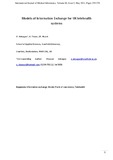JavaScript is disabled for your browser. Some features of this site may not work without it.
| dc.contributor.author | Adeogun, Oluseun | - |
| dc.contributor.author | Tiwari, Ashutosh | - |
| dc.contributor.author | Alcock, Jeffrey R. | - |
| dc.date.accessioned | 2011-05-06T23:11:22Z | |
| dc.date.available | 2011-05-06T23:11:22Z | |
| dc.date.issued | 2011-05-01T00:00:00Z | - |
| dc.identifier.citation | O. Adeogun, A. Tiwari, J.R. Alcock, Models of information exchange for UK telehealth systems, International Journal of Medical Informatics, Volume 80, Issue 5, 2011, Pages 359-370 | |
| dc.identifier.issn | 1386-5056 | - |
| dc.identifier.uri | http://dx.doi.org/10.1016/j.ijmedinf.2011.01.013 | - |
| dc.identifier.uri | http://dspace.lib.cranfield.ac.uk/handle/1826/5304 | |
| dc.description.abstract | Aim: The aim of the paper was to identify the models of information exchange for UKtelehealth systems.Methodology: Twelve telehealth offerings were evaluated and models representing theinformation exchange routes were constructed. Questionnaires were used to validate thediagrammatical representations of the models with a response rate of 55%.Results: The models were classified as possessing four sections: preparing for data transfer,data transfer, information generation and information transfer from health professional topatient.In preparing for data transfer, basic data entry was automated in most systems thoughadditional inputs (i.e. information about diet, lifestyle and medication) could be enteredbefore the data was sent into the telehealth system. For the data transfer aspect, results andadditional inputs were sent to intermediate devices, which were connectors between pointof-care devices, patients and health professionals. Data were then forwarded to either a webportal, a remote database or a monitoring/call centre. Information generation was eitherthrough computational methods or through the expertise of health professionals. Informationtransfer to the patient occurred in four forms: email, telehealth monitor message, textmessage or phone call.Conclusion: On comparing the models, three generic models were outlined. Five differentforms of information exchange between users of the system were identified: patientpush,system-stimulation, dialogue, health professional-pull and observation. Patient-pushand health professional-pull are the dominant themes from the telehealth offeringsevaluated. | en_UK |
| dc.language.iso | en_UK | en_UK |
| dc.publisher | Elsevier Science B.V., Amsterdam. | en_UK |
| dc.rights | NOTICE: this is the author’s version of a work that was accepted for publication in International Journal of Medical Informatics Changes resulting from the publishing process, such as peer review, editing, corrections, structural formatting, and other quality control mechanisms may not be reflected in this document. Changes may have been made to this work since it was submitted for publication. A definitive version was subsequently published in International Journal of Medical Informatics, VOL 80, ISSUE 5, (2011) DOI: 10.1016/j.ijmedinf.2011.01.013 | |
| dc.title | Models of information exchange for UK telehealth systems | en_UK |
| dc.type | Article | en_UK |
Files in this item
This item appears in the following Collection(s)
-
Staff publications (SAS) [907]
